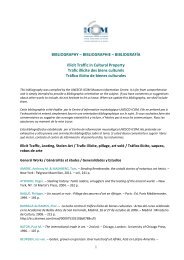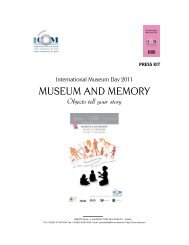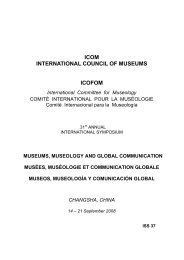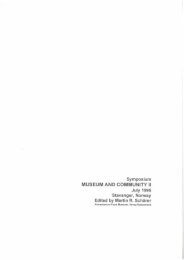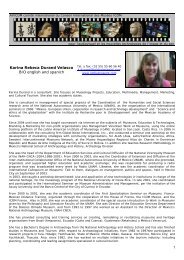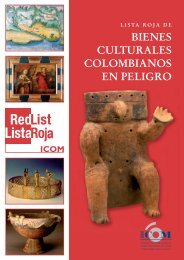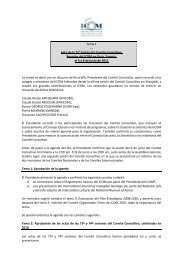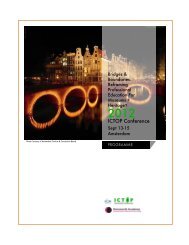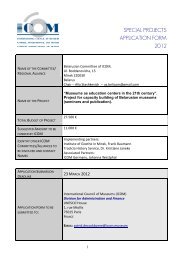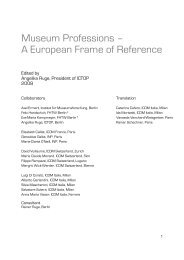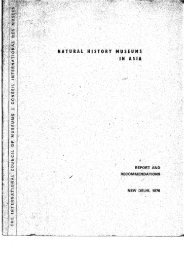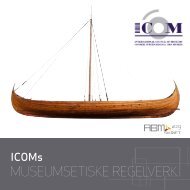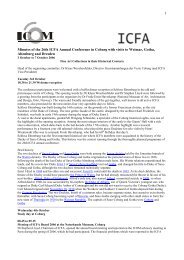Key Concepts of Museology - ICOM
Key Concepts of Museology - ICOM
Key Concepts of Museology - ICOM
You also want an ePaper? Increase the reach of your titles
YUMPU automatically turns print PDFs into web optimized ePapers that Google loves.
68<br />
Committee for the Training <strong>of</strong> Personnel)<br />
has listed twenty <strong>of</strong> them<br />
(Ruge, 2008).<br />
1. Many employees, <strong>of</strong>ten the<br />
majority <strong>of</strong> people working in the<br />
institution, follow a career path<br />
which has only a relatively superfi<br />
cial relationship with the very<br />
principle <strong>of</strong> the museum – whereas<br />
to the wider public, they personify<br />
museums. This is the case with<br />
security <strong>of</strong>fi cers or guards, the staff<br />
responsible for the surveillance <strong>of</strong><br />
exhibition areas in the museum,<br />
who are the main contacts with the<br />
public, like the receptionists. The<br />
specifi city <strong>of</strong> museum surveillance<br />
(precise measures for security and for<br />
evacuating the public and the collections<br />
etc.) has gradually throughout<br />
the 19 th century imposed specifi c<br />
recruitment categories, in particular<br />
that <strong>of</strong> a body which is separate from<br />
the rest <strong>of</strong> the administrative staff.<br />
At the same time it was the fi gure <strong>of</strong><br />
the curator who appeared as the fi rst<br />
specifi cally museal pr<strong>of</strong>ession. For a<br />
long time the curator was in charge<br />
<strong>of</strong> all tasks directly relating to the<br />
objects in the collection, that is their<br />
preservation, research and communication<br />
(PRC model, Reinwardt<br />
Academie). The curator’s training is<br />
fi rstly associated with the study <strong>of</strong><br />
the collections (art history, natural<br />
sciences, ethnology etc.) even if, for<br />
several years now, it has been backed<br />
up by a more museological training<br />
such as that given by a number <strong>of</strong><br />
universities. Many curators who have<br />
specialised in the study <strong>of</strong> the collections<br />
– which remains uncontested as<br />
their main fi eld <strong>of</strong> activity - cannot<br />
call themselves either museologists,<br />
or museographers (museum practitioners),<br />
even if in practice some <strong>of</strong><br />
them easily combine these different<br />
aspects <strong>of</strong> museal work. In France,<br />
unlike other European countries, the<br />
body <strong>of</strong> curators is generally recruited<br />
by competition and benefi ts from<br />
a specifi c training school (Institut<br />
national du Patrimoine/the National<br />
Heritage Institute).<br />
2. The term museologist can be<br />
applied to researchers studying the<br />
specifi c relationship between man<br />
and reality, characterised as the<br />
documentation <strong>of</strong> the real by direct<br />
sensory perception. Their fi eld <strong>of</strong><br />
activity essentially concerns theory<br />
and critical thinking in the museal<br />
fi eld, so they may work elsewhere<br />
than in a museum, for example in<br />
a university or in other research<br />
centres. The term is also applied by<br />
extension to any person working for<br />
a museum and holding the function<br />
<strong>of</strong> project leader or exhibition programmer.<br />
So museologists differ<br />
from curators, and also from museographers,<br />
who are responsible for the<br />
design and general organisation <strong>of</strong><br />
the museum and its security, conservation<br />
and restoration facilities along<br />
with the exhibition galleries, whether<br />
permanent or temporary. Museographers,<br />
with their specifi c technical<br />
skills, have an expert vision <strong>of</strong> all the<br />
ways in which a museum operates –<br />
preservation, research and communication<br />
– and by drawing up the<br />
appropriate specifi cations they can<br />
manage the information connected



